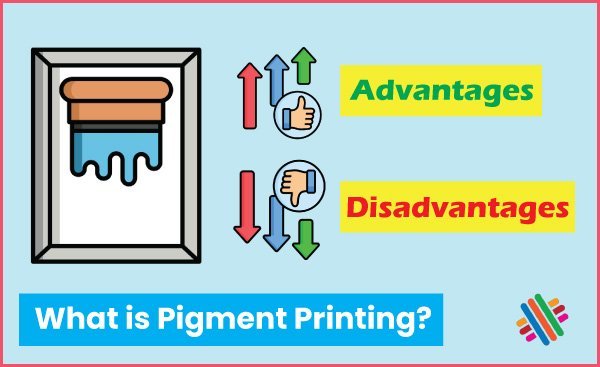What is Pigment Printing | Advantages and Disadvantages of Pigment Printing
Last updated on August 23rd, 2023 at 11:25 am
Definition of Pigment
A substance in particulate from that is substantially insoluble in a medium but which can be mechanically dispersed in this medium to modify its color and light – scattering properties.
In other words, Pigments are insoluble coloring matter mostly mineral origin have been used for the coloration of metal wood, stone, and textile material.
Definition of Pigment Printing
Pigments are colors which do not dissolve and penetrate into the fibres. They have not to be applied together with a film forming binder. More than 50% of all printing colors are pigment types. It represents an alternative to direct printing. In this system there is no need to carry out a steaming process, as steaming is replaced by polymerization (generally carried out simultaneously with drying).

This type of printing process is very simple, low-cost and can be carried out easily on all types of fabrics, particularly on blends, since pigments can adhere to all fibres; there is no need to use dyes of different color classes. On the other hand, the adhesives, which bind the pigment to the fabric, can give serious problems when the fabric hand varies. For prints with a low coverage ratio, the hand variation can be acceptable but it is not when the coverage ratio is high or at least for all uses. Furthermore, the pigment lies on the surface and has low fastness to friction (this depends mainly upon the type and quantity of binding agent and upon the polymerization degree). Some valid alternatives to this type of printing can give special effects such as printing with swelling agents (generally synthetic polyurethane-base pastes are used), with covering pigments and glitter (metal powders or particles of plastic materials) etc.
Advantages of Pigment Printing
- Applicable to natural and synthetic fibre.
- Wide range of color can be produced.
- Can be used for dope dyeing for filament yarn.
- Easily applicable.
- Less expensive.
- Maximum output of goods because of the elimination of washing-off, quick sampling and high printing speed.
- It presents the fewest problems for the printer of all the coloration processes, with regard to labor costs, equipment and reliability of production.
- Properly produced pigment prints, using selected products, have an unsurpassed fastness to light and good general fastness properties.
- Extremely well suited for color resist effects, for example, under azoic and reactive dyes.
- From the economical point of view, pigment printing, using pastes free from white spirit, is more acceptable than any other systems, excepting transfer printing methods.
Disadvantages of Pigment Printing
- Not controllable for the binder film.
- Use of solvent like kerosene, spirit etc can produce problems like flammability, odor, pollution etc.
- The jamming up of equipment and air and water pollution is observed.
- Wet and rubbing fastness is average.
- The handle of the printed goods is often unduly hard because of the large amounts of external cross linking agents.
- Are sensitive to crushing during roller printing and pigment printing needs shallow engravings on screen printing.
- The original surface of the textile material is covered by the binder film. This is occasionally aesthetically effective but usually undesirable.
You may also like: A Guide to Reactive Printing Process

nice
Woah! I’m enjoying the template/theme of this website. It’s simple, yet effective. A lot of times it’s very hard to get that “perfect balance” between superb usability and visual appeal. I must say you’ve done a very good job with this.